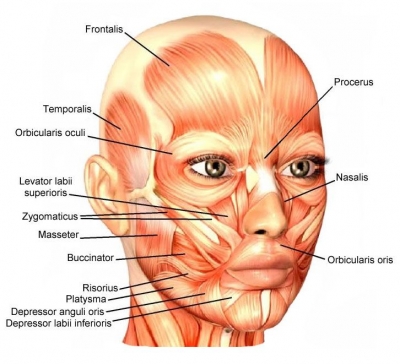
Frontalis
This flat muscle wrinkles the forehead and raises the eyebrows. Specifically, this muscle originates from the galea aponeurotica and extends down the forehead and inserts or attaches to the skin around the eyebrows and top of the nose.
Temporalis
The temporalis muscle is a thin, fan-shaped muscle situated within the temporal fossa of the skull. You can feel these chewing muscles by touching the side of your head while moving your jaw.
Procerus
Procerus is a small, triangular muscle of the head that occupies the glabella, which is the region located between the eyebrows. This procerus muscle wrinkles the bridge of the nose.
Corrugator supercilii
Corrugator supercilii is a small, pyramidal muscle that belongs to the circumorbital and palpebral group of facial muscles, along with the levator palpebrae superioris and orbicularis oculi muscles. When this short, narrow muscle is flexed it pulls the eyebrows together and down to form a frown.
Auricularis superior
This is one of three muscles surrounding the outer ear. It is a thin, fan-shaped muscle that arises from the temporal fascia (connective tissue along the side of the head) and descends into the root of the auricle, or ear. The other muscles in this region include the auricularis posterior and the auricularis anterior.
Orbicularis oculi
Orbicularis oculi is a paired facial muscle that surrounds each orbit and the adjacent periorbital region. The circular muscle around the eye socket closes the eye.
Nasalis
Superficial muscles in the nose are used to flare the nostrils. It consists of two parts; alar and transverse. The alar part is also called dilator naris posterior, and the transverse part is known also as the compressor naris. Together with procerus, levator labii superioris alaeque nasi and depressor septi muscles, nasalis belongs to the nasal group of facial muscles.
Zygomaticus
Zygomaticus major is a thin paired facial muscle that extends diagonally from the zygomatic bone (hence the name) to the angle of the mouth The zygomaticus muscles raise the corners of the mouth to smile.
Levator labii superioris
Levator labii superioris is a short, paired triangular muscle of the face. It belongs to the buccolabial group of muscles of facial expression. The upper lip is lifted by this muscle.
Masseter
Masseter muscle is a paired, strong, thick and rectangular muscle that is originating from the zygomatic arch and extends down to the mandibular angle. The most powerful chewing muscle, the masseter is used to close the jaw.
Buccinator
Buccinator is a thin quadrilateral facial muscle that is the main component of the cheek. This muscle keeps food in the mouth by holding the cheek close to the teeth during chewing.
Orbicularis oris
Orbicularis oris is a complex circular muscle that surrounds the orifice of the mouth and forms the majority of the lips. This round muscle purses the lips, and shapes the mouth when speaking. It is also used for whistling and kissing.
Platysma
The platysma is a thin sheet-like muscle that lies superficially within the anterior aspect of the neck. This sheet of muscle helps pull the lower lip and corner of the mouth sideways and down.
Mentalis
Mentalis is a paired conical facial muscle located in the chin. The mentalis wrinkles the chin and pushes the lower lip out.
Picture Credit : Google




